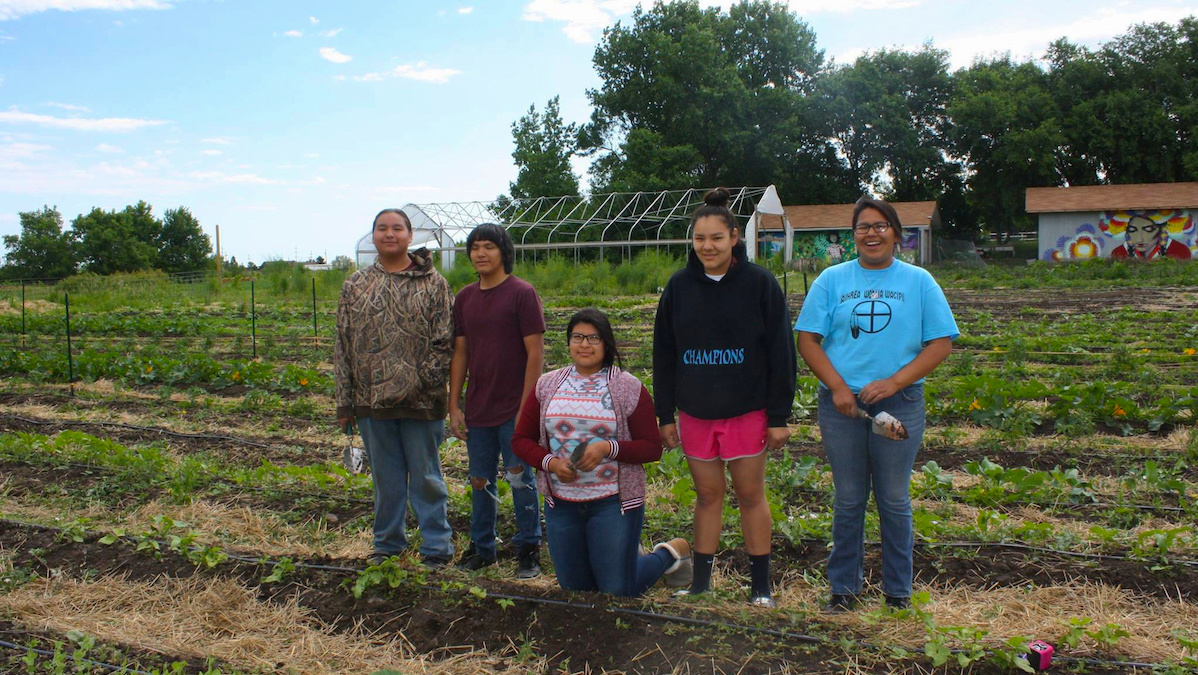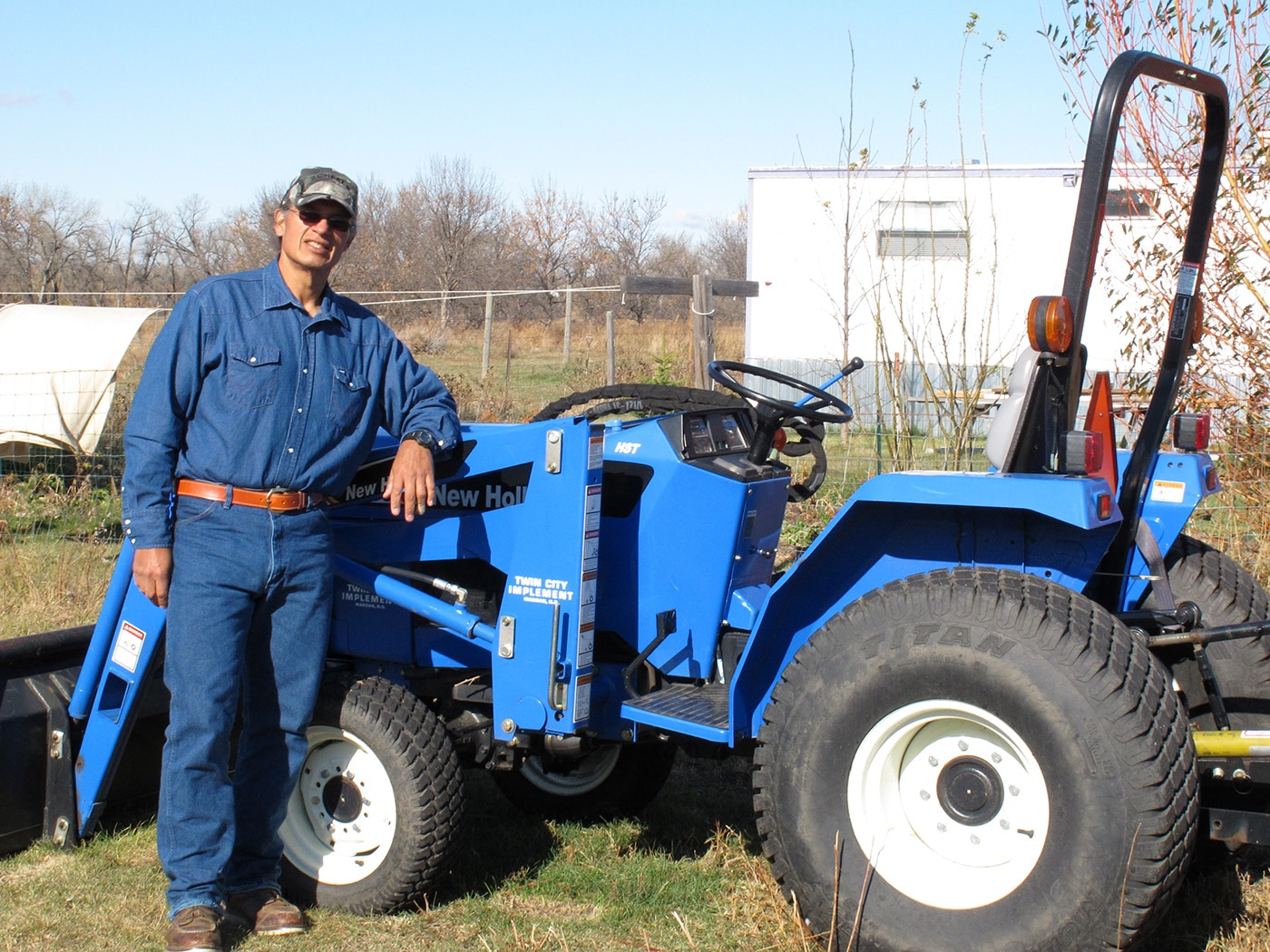

Garden interns learn plant and weed identification at the Cheyenne River Youth Project in Eagle Butte, South Dakota. Cheyenne River Youth Project / Facebook
By Stephanie Woodard
Many Americans are now experiencing an erratic food supply for the first time. Among COVID-19’s disruptions are bare supermarket shelves and items available yesterday but nowhere to be found today. As you seek ways to replace them, you can look to Native gardens for ideas and inspiration.
“Working in a garden develops your relationship to the land,” says Aubrey Skye, a Hunkpapa Lakota gardener. “Our ancestors understood that. Look at the old pictures. It’s etched on their faces. When you understand it as well, a sense of scarcity and insecurity transforms into a feeling of abundance and control—something we all need these days.” For several years, Skye ran a CDC-sponsored gardening program on Standing Rock, a reservation that straddles North and South Dakota. He created hundreds of productive plots, large and small, for fellow tribal members.
Tribes’ food-scarcity problems developed after signing treaties with the United States in the 18th and 19th centuries. Under these agreements, tribes typically transferred land to the federal government in return for education, health care, and other services. The diminished tribal homelands that resulted, along with continual federal efforts to decrease Native land holdings, severely restricted the hunting, fishing, and other activities with which tribes had fed their people since time immemorial. To force tribes onto reservations, Skye adds, the United States purposely destroyed critical food sources, such as the huge buffalo herds that once roamed the Plains.

Aubrey Skye, Standing Rock Sioux tribal member, tills gardens for himself and other tribal members. He does some by hand, and others with this tractor. Photo by Stephanie Woodard.
Abundant lifeways were decimated. Starvation and death ensued. Massacres, such as Wounded Knee and Sand Creek, killed additional American Indians, as did forced removals from homelands, with the Cherokee Trail of Tears and the Navajo Long Walk among the best-known. The injustices continue today. Oil and gas pipelines, mines, industrial animal farms, and other projects may be sited to imperil tribal lands rather than those of other peoples. Poverty, limited health care, and, in some areas, lack of running water for frequent anti-virus hand-washing, means the COVID-19 pandemic has hit certain tribes, notably the Navajo Nation, hard.
Growing Strength
Incessant disasters have created economic and social burdens, including hunger, that fall heavily on children. “These tragedies are so hard on kids,” says the Cheyenne River Youth Project’s director Julie Garreau. The project is on the Cheyenne River Sioux Reservation, in South Dakota, just south of Standing Rock. “Don’t ever let people tell you children don’t know what’s going on,” she says. “The pandemic is creating enormous additional stress, beyond what they were already struggling with.”
Her program works to make up the difference. With its 2.5-acre garden, café, gym, and library, the organization has long provided children with good food and a safe place to learn and have fun. Now that tribal children are sheltering at home, the youth project’s garden and the sack meals her organization delivers ensure that, at the very least, they have healthy food each day, says Garreau, who is a tribal member.
“I’m so grateful,” she says. “We’re a nonprofit, and our funders contacted us—we didn’t go to them—and gave us support for meals with a hot entrée, juice, and a healthy snack like fruit or nuts. We started driving around in our pickup with food for 35 kids, then 50, then 75.” The youth project is working to get the word out. “We hope to reach 250 kids,” Garreau says.
Dream of Wild Health also focuses on youth as it restores the multitribal urban-Indian community of Minneapolis and St. Paul to physical well-being and a spiritual relationship to the Earth. “We grow leaders and seeds,” says Community Outreach and Culture Teacher Hope Flanagan, who is Seneca. “An urban upbringing can mean our youth lose track of our old way of walking on this Earth.” Dream of Wild Health helps the children relearn this knowledge, she says.
In the process, the group’s activities help the community reclaim food sovereignty—ready access to healthy, affordable, culturally appropriate food—according to Executive Director Neely Snyder, a St. Croix Chippewa tribal member. Dream of Wild Health meets this need by distributing crops that it grows on its nearby 30-acre farm: It participates in a farmers market, delivers household shares of farm produce to locations in Native neighborhoods of both Minneapolis and St. Paul, and partners with other community organizations, such as the Minneapolis American Indian Center.
Since the COVID-19 challenges began, innovation has been key. To continue to offer chef-led cooking lessons for youth, yet maintain social distance, Dream of Wild Health delivers ingredients to the children’s homes and runs the program via a video link. Virtual activities have proven popular. When a seed-saving and sacred medicines workshop moved online, the typical 40- to 50-person audience for a live event burgeoned to some 220, Snyder says.
To grow real crops in a real garden requires getting out on the land—with a difference nowadays. This summer, Skye anticipates, reservation gardeners will either work alone or in groups practicing social distancing. Dream of Wild Health farmers are figuring out how student interns, whom they call Garden Warriors, can work on the group’s farm and maintain distance.
While gardening, Skye says, tribal gardeners will put into action traditional practices that arise from close observations of nature and the belief that humans, plants, animals, and other aspects of the natural world form a mutually reliant community. We are all related, Skye says. “Gardening and eating food you’ve raised give you a direct connection to Mother Earth.”
Gardeners are necessarily optimists. At a time when our world is so dangerous, the garden is a place of refuge. “We will come out of this crisis,” Garreau said in an email. “To do so, we must not stop planning and planting.” Taking cues from Native gardening practices can help even novice gardeners get growing in these difficult circumstances.
Follow Indigenous gardeners’ advice to grow your own plot, however small or experimental. At a time when stay-at-home orders continue to try and keep populations healthy, Garreau sums up the importance of sinking your hands into the soil: “Gardens represent so much more,” Garreau continued. “Food, yes, but a belief in our future. Gardens represent resiliency, strength, wellness, culture.”
1. Plot Your Success
Experienced gardeners may be comfortable planting big fields of their favorite crops. Skye has a nearly 1-acre plot just downhill of his Standing Rock home. But if this is your gardening debut—as it was for some tribal members he provided with gardens through the CDC project—ensure success by starting small. Try a few pots or raised beds, or perhaps a small in-ground plot, with easy-to-grow plants, he says. Good options might be tomatoes, peppers, green beans, radishes, summer and winter squash, onions, or leafy greens. “Don’t bite off more than you can chew!” Skye quips.
2. Cultivate Plant Friendships
Many American gardeners know about the Three Sisters—in the celebrated trio, cornstalks serve as trellises for beans, which in turn fix nitrogen (fertilizer), while big, flat squash leaves conserve soil moisture and keep down weeds. Such plant groupings, also called companion plants, are expressions of cooperation and sharing, says the Mohawk director of the Traditional Native American Farmers Association, Clayton Brascoupé. “Your garden should be like a healthy forest, which has trees of various sizes,” he says. “Look at nature, and figure out combinations that mimic it.”
In his gardens at Tesuque Pueblo, north of Santa Fe, you can see peas twining up corn plants and basil rising above the broad, flat leaves of watermelon. “Experiment!” he says. “Plants can surprise you. One year, we discovered that garbanzos and corn really enjoy each other.”
3. Make Room for Hard-Working Beauties
Embellish your garden with colorful flowers, particularly those native to your area. “They attract bees, butterflies, hummingbirds, and other pollinators,” says Skye, adding that pollinators are an integral part of a plant’s life cycle. “Without them, the harvest wouldn’t happen, and we would be looking at extreme food shortages, not just occasional gaps. By giving pollinators flowers they like, we support them, just as they support us.”
4. Keep Crops Cozy
Got a plant that’s struggling? Give it a rock! Brascoupé explains that in Southwest Native gardens, rocks are commonly set next to seedlings or plants that need help. They act as heat sinks, smoothing out day-night temperature variations as they soak up the sun’s heat and release it in evening’s chill. The practice may have been more widespread, he says, appearing as far north as Iroquois gardens in the U.S. Northeast. It makes sense, he says; in a cold region, rocks protect seedlings from unexpected early-season frost.
5. Source Materials Locally and for Free
For no-cost drip irrigation, Brascoupé uses a fine needle to poke a hole in the neck of clean soda-pop bottles or milk jugs. He then fills the containers with water, replaces their caps, and pushes their pierced necks into the soil.
Conserve soil moisture and keep weeds down by surrounding the plants with mulching materials that would otherwise have been discarded. People spend time and money getting rid of cardboard, shredded office paper, lawn clippings, and leaves, Brascoupé says. “Tell neighbors, ‘I can take that off your hands.’ Build human relationships.”
6. Embrace Dandelions
Don’t banish dandelions. Welcome these supposed weeds! Their leaves are delicious and nutritious, and their taproots break up hardened soil, I learned from Native gardeners. My New York City backyard used to be so compacted, little grew there. I tried scattering dandelion seeds around the yard. They grew and blossomed, and soon earthworms moved in. The soil became soft, friable, and plant-friendly. Earthworms are at it 24-7, working on your behalf, according to Skye. “What more could you ask for?” he says.
7. Include Healing Herbs
Skye has a small medicine-wheel garden by his home, where he delights in growing echinacea, chamomile, comfrey, and other medicinals from seed he saves from one year to the next. Such circular plots are traditionally places to grow herbs and thereby experience their delectable flavors and the natural healing they promote.
8. Save Your Seeds
At the end of the season, save the seeds of plants that thrived—and that you enjoyed—in your garden. You can help ensure your future food supply and, if you include unusual or heritage varieties, do your part to sustain biodiversity.
Seed-saving preserves history as well, Skye says. He called seeds time capsules. “We Native people have always saved them. As we plant, and save, and replant, the seeds go through all we are going through, the good times and the bad.” The Dream of Wild Health seed collection, for example, includes a Cherokee family’s gift of corn that survived the tribe’s deadly Trail of Tears, a forced march that displaced their ancestors from their original homelands.
Today, danger confronts all of us on this Earth. “We were already facing climate change, and now there is the pandemic,” Skye says. The seeds will always be there, to provide both food and a spiritual connection to the Earth, he says. “They are how we will survive.”
Garreau echoes this sentiment: “When we come out of this terrible pandemic, we will have learned to be stronger. We will be invincible.”
Reposted with permission from YES! Magazine.
- 'This Is History in the Making': Cherokee Nation Is First U.S.-Based ...
- Three Sisters Garden — How to Plant Corn, Squash & Beans Together
- 28 Organizations Promoting Indigenous Food Sovereignty - EcoWatch
- The Environmental Benefits of Proper Tree Maintenance - EcoWatch

 233k
233k  41k
41k  Subscribe
Subscribe 